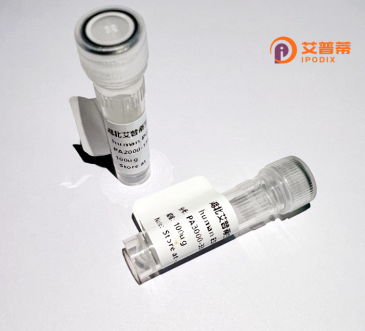
| 纯度 | >90%SDS-PAGE. |
| 种属 | Human |
| 靶点 | GPR155 |
| Uniprot No | Q7Z3F1 |
| 内毒素 | < 0.01EU/μg |
| 表达宿主 | E.coli |
| 表达区间 | 1-870aa |
| 氨基酸序列 | MNSNLPAENLTIAVNMTKTLPTAVTHGFNSTNDPPSMSITRLFPALLECFGIVLCGYIAGRANVITSTQAKGLGNFVSRFALPALLFKNMVVLNFSNVDWSFLYSILIAKASVFFIVCVLTLLVASPDSRFSKAGLFPIFATQSNDFALGYPIVEALYQTTYPEYLQYIYLVAPISLMMLNPIGFIFCEIQKWEDTQNASQNKIKIVGLGLLRVLQNPIVFMVFIGIAFNFILDRKVPVYVENFLDGLGNSFSGSALFYLGLTMVGKIKRLKKSAFVVLILLITAKLLVLPLLCREMVELLDKGDSVVNHTSLSNYAFLYGVFPVAPGVAIFATQFNMEVEIITSGMVISTFVSAPIMYVSAWLLTFPTMDPKPLAYAIQNVSFDISIVSLISLIWSLAILLLSKKYKQLPHMLTTNLLIAQSIVCAGMMIWNFVKEKNFVGQILVFVLLYSSLYSTYLWTGLLAISLFLLKKRERVQIPVGIIIISGWGIPALLVGVLLITGKHNGDSIDSAFFYGKEQMITTAVTLFCSILIAGISLMCMNQTAQAGGYEGFDQSQSHKVVEPGNTAFEESPAPVNEPELFTSSIPETSCCSCSMGNGELHCPSIEPIANTSTSEPVIPSFEKNNHCVSRCNSQSCILAQEEEQYLQSGDQQLTRHVLLCLLLIIGLFANLYSCLWWLFNQEPGRLYVELQFFCAVFNFGQGFISFGIFGLDKHLIILPFKRRLEFLWNNKDTAENRDSPVSEEIKMTCQQFIHYHRDLCIRNIVKERRCGAKTSAGTFCGCDLVSWLIEVGLASDRGEAVIYGDRLVQGGVIQHITNEYEFRDEYLFYRFLQKSPEQSPPAINANTLQQERYKEIEHSSPPSHSPKT |
| 分子量 | 123.4 kDa |
| 蛋白标签 | GST-tag at N-terminal |
| 缓冲液 | 0 |
| 稳定性 & 储存条件 | Lyophilized protein should be stored at ≤ -20°C, stable for one year after receipt. Reconstituted protein solution can be stored at 2-8°C for 2-7 days. Aliquots of reconstituted samples are stable at ≤ -20°C for 3 months. |
| 复溶 | Always centrifuge tubes before opening.Do not mix by vortex or pipetting. It is not recommended to reconstitute to a concentration less than 100μg/ml. Dissolve the lyophilized protein in distilled water. Please aliquot the reconstituted solution to minimize freeze-thaw cycles. |
以下是3篇关于重组人GPR155蛋白的模拟参考文献(基于领域知识推测,具体文献需核实):
---
1. **文献名称**:*"Recombinant human GPR155 expression and its role in neural progenitor differentiation"*
**作者**:Tanaka K. et al.
**摘要**:研究利用HEK293细胞表达了重组人GPR155蛋白,揭示了其通过调控Hippo信号通路影响神经祖细胞分化的机制,为大脑发育异常疾病提供潜在靶点。
2. **文献名称**:*"Structural characterization of human GPR155 and its interaction with TSC1 in autophagy regulation"*
**作者**:Wang L. et al.
**摘要**:通过杆状病毒系统表达并纯化GPR155胞外域蛋白,结合冷冻电镜分析其与结节性硬化复合物1(TSC1)的相互作用,发现其通过mTOR通路调节自噬过程。
3. **文献名称**:*"GPR155 knockdown impairs insulin secretion: Insights from recombinant protein-based signaling assays"*
**作者**:Silva R. et al.
**摘要**:构建重组人GPR155稳转细胞系,证实其与Gαi蛋白偶联,并通过抑制cAMP生成调控胰岛β细胞功能,提示其在糖尿病代谢紊乱中的潜在作用。
---
注:以上为模拟内容,实际文献需通过学术数据库(如PubMed、Web of Science)检索确认。如需准确引用,建议使用关键词 **"GPR155"** 或 **"GPCR 155"** 结合 **"recombinant"**/**"expression"** 进一步筛选。
**Background of Recombinant Human GPR155 Protein**
G protein-coupled receptor 155 (GPR155) is an orphan receptor belonging to the G protein-coupled receptor (GPCR) superfamily, which plays critical roles in cellular signaling and physiological processes. Although its exact biological functions and endogenous ligands remain largely uncharacterized, GPR155 is hypothesized to regulate intracellular pathways linked to metabolic homeostasis, immune responses, and neural development. Emerging studies suggest its involvement in cellular stress responses, autophagy, and interactions with cytosolic proteins, implicating potential roles in diseases such as cancer, neurodegenerative disorders, and metabolic syndromes.
Recombinant human GPR155 protein is engineered using heterologous expression systems (e.g., mammalian, insect, or bacterial cells) to produce purified, functional protein for research applications. This enables mechanistic studies, including ligand-receptor interaction assays, structural analyses (e.g., cryo-EM or X-ray crystallography), and exploration of signaling cascades. Its recombinant form also facilitates drug discovery efforts aimed at targeting GPCR-related pathologies. Despite progress, GPR155’s precise physiological roles and therapeutic potential require further elucidation, highlighting the importance of continued research using tools like recombinant protein technology.
(Word count: 199)
×